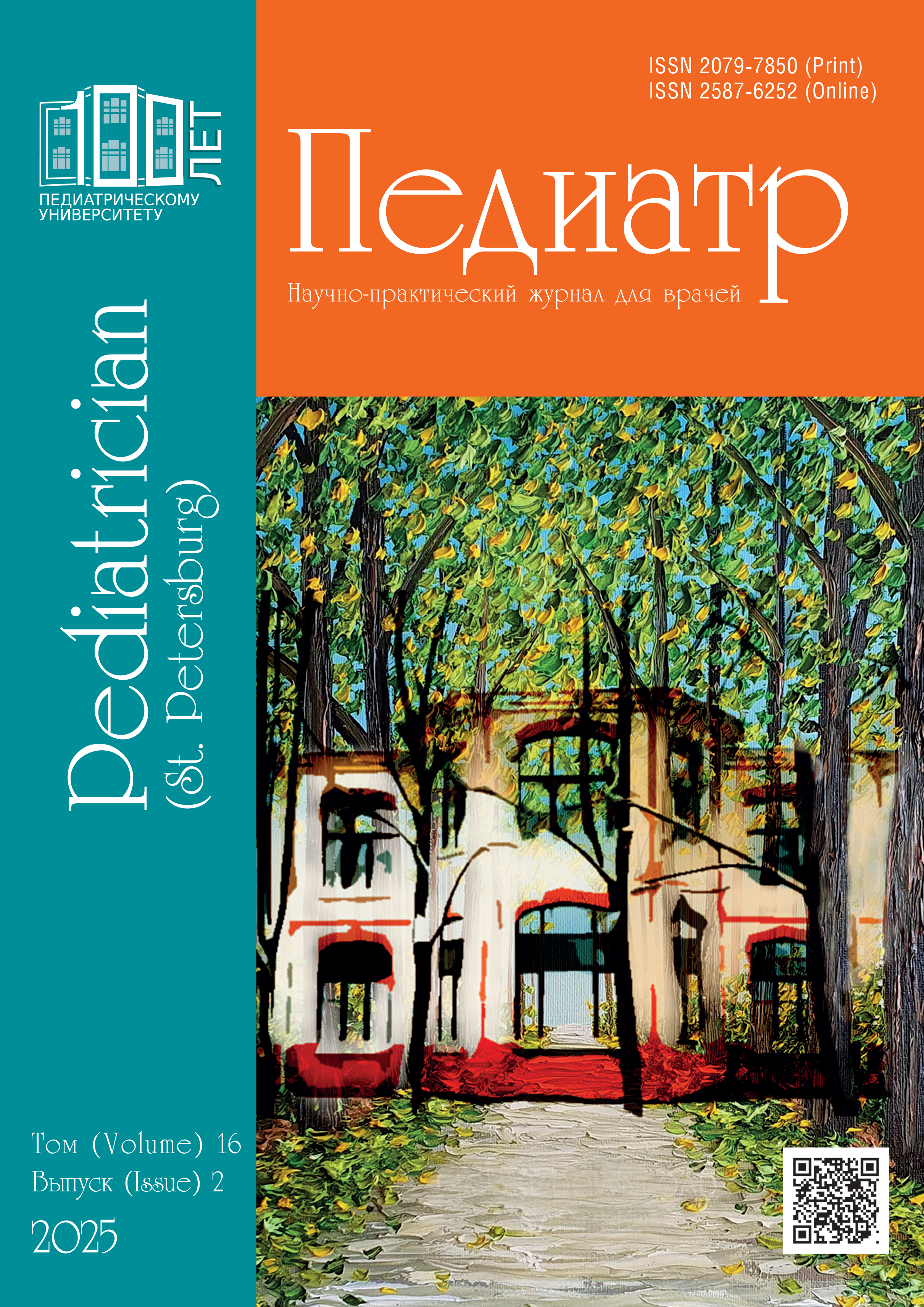Epileptic encephalopathies and developmental encephalopathies of infancy. Clinical observations. The experience of the Perinatal Center of St. Petersburg State Pediatric Medical University
Abstract
The relevance of studying epileptic encephalopathies and developmental encephalopathies (EE and ER). In young children, it is due to the complexity of diagnosing this pathology, especially in neonatal and infancy, the formation of persistent neurological deficits, disability and social maladaptation of patients. The main causes of neonatal encephalopathy are hypoxic-ischemic lesions of the central nervous system, perinatal infections, placental abnormalities, metabolic disorders, coagulopathy and hemorrhages during the newborn period. In addition, individual gene mutations associated with EE and ER have now been identified. The article provides brief literature data on the etiology and clinical variants of EE and ER in infancy, their role in the subsequent formation of cognitive and motor disorders, autism spectrum disorders (including disorders of social interaction, speech development and stereotypy), pharmacoresistant epilepsy. The role of electroencephalographic examination in the diagnosis of epileptic encephalopathies of the neonatal period is shown. The necessity of genetic testing of children with neonatal seizures is substantiated. The work also describes the own observations of 4 patients who were in the Perinatal Center of St. Petersburg State Medical University with diagnosed early developmental encephalopathy and epileptic encephalopathy, with a description of the etiology, clinical picture, features of paroxysmal conditions and their therapy, neuroimaging data, electroencephalographic phenomena.
References
Алиханов А.А. Эпилептические энцефалопатии раннего детского возраста. В кн.: Эпилептология детского возраста. А.С. Петрухин, ред. М.: Медицина; 2000: 203–226.
Белоусова Е.Д., Шарков А.А. Трудности в диагностике эпилептических энцефалопатий. Журнал неврологии и психиатрии им. С.С. Корсакова. 2019;119(11, вып. 2):34–40.
Богданова Н.М., Кравцова К.А. Роль кишечной микробиоты в генезе эпилепсии. Детская медицина Северо-Запада. 2024;12(2):102–117. DOI: 10.56871/CmN-W.2024.56.72.009.
Мелашенко Т.В., Лаптиев С.А., Иванов Д.О. Эпилепсии и эпилептические энцефалопатии неонатального/раннего возраста, обусловленные наследственными каналопатиями. Методические рекомендации. СПбГПМУ; 2022.
Мухин К.Ю., Пылаева О.А., Какаулина В.С., Бобылова М.Ю. Определение и классификация эпилепсии. Проект Международной противоэпилептической лиги по классификации и дефиниции эпилептических синдромов от 2021 г. Русский журнал детской неврологии. 2022;17(1):6–95. DOI: 10.17650/2073-8803-2022-17-1-6-95.
Фомина М.Ю. Неонатальные судороги. В кн.: Эпилепсия и неэпилептические пароксизмальные состояния у детей. В.И. Гузева, ред. М.: Медицинское информационное агентство; 2007: 355–443. EDN: OUVXTB.
Фомина М.Ю., Ракова М.А., Ефет Е.А., Павлова О.И., Лязина Л.В. Злокачественные мигрирующие парциальные приступы младенчества: описание клинических наблюдений. Педиатр. 2020;11(1):73–81. DOI: 10.17816/PED11173-81.
Фомина М.Ю., Мелашенко Т.В, Пальчик А.Б., Понятишин А.Е. Судороги новорожденных. М.: МЕДпресс-информ; 2023.
Aicardi J., Ohtahara S. Severe neonatal epilepsies with suppression-bursts pattern. In: Epileptic syndromes in infancy, childhood and adolescence. 4-th ed. Ed. J. Roger, M. Bureau et al. Un. Kingdom: John Libbey & CoLtd; 2005.
Hamdan F.F., Myers C.T., Cossette P., Lemay P., Spiegelman D., Lemay P., Spiegelman D., Laporte A.D., Nassif C., Diallo O., Monlong J., Cadieux-Dion M., Dobrzeniecka S., Meloche C., Retterer K., Cho M.T., Rosenfeld J.A., Bi W., Massicotte C., Miguet M., Brunga L., Regan B.M., Mo K., Tam C., Schneider A., Hollingsworth. High rate of recurrent de novo mutations in developmental and epileptic encephalopathies. Am J Hum Genet. 2017;101(5):664–685. DOI: 10.1016/j.ajhg.2017.09.0089.
Happ H.C., Carvill G.L. A 2020 view on the genetics of developmental and epileptic encephalopathies. Epilepsy Curr. 2020;20(2):90–96. DOI: 10.1177/1535759720906118.
Kalser J., Cross J.H. The epileptic encephalopathy jungle — from Dr West to the concepts of aetiology-related and developmental encephalopathies. Curr Opin Neurol, 2018;31: 216–222.
McRae J.F., Clayton S., Fitzgerald T.W. et al. Prevalence and architecture of de novo mutations in developmental disorders. Nature. 2017;7642(542):433–438.
McTague A., Howell K.B., Cross J.H., Kurian M.A., Scheffer I.E. The genetic landscape of the epileptic encephalopathies of infancy and childhood. Lancet Neurol. 2016;15(3):304–316. DOI: 10.1016/S1474-4422(15)00250-1.
Mercimek-Mahmutoglu S., Patel J., Cordeiro D., Hewson S., Callen D., Donner E.J., Hahn C.D., Kannu P., Kobayashi J., Minassian B.A., Moharir M., Siriwardena K., Weiss S.K., Weksberg R., Snead O.C. Diagnostic yield of genetic testing in epileptic encephalopathy in childhood. Epilepsia. 2015;56(5):707–716.
Myers K.A., Johnstone D., Dyment D.A. Epilepsy genetics: current knowledge, applications and future directions. Clin Genet. 2019;95(1):95–111. DOI: 10.1111/cge.13414.
Nabbout R., Dulac O. Epileptic encephalopathies: a brief overview. J Clin Neurophysiol. 2003;20:393–397. DOI: 10.1097/00004691-200311000-00002.
Na J.H., Shin S., Yang D., Kim B., Kim H.D., Kim S., Lee J.S., Choi J.R., Lee S.T., Kang H.C. Targeted gene panel sequencing in early infantile onset developmental and epileptic encephalopathy. Brain Dev. 2020;42(6):438–448. DOI: 10.1016/j.braindev.2020.02.004.
OMIM: Online Mendelian Inheritance in Man, an online catalog of human genes and genetic disorders. Available at: https://omim.org (accessed: 05.04.2025).
Patel J., Mercimek-Mahmutoglu S. Epileptic encephalopathy in childhood: a stepwise approach for identification of underlying genetic causes. Indian J Pediatr. 2016;83(10):1164–1174. DOI: 10.1007/s12098-015-1979-9.
Raga S., Specchio N., Rheims S., Wilmshurst J.M. Developmental and epileptic encephalopathies: recognition and approaches to care. Epileptic Disord. 2021;23(1):40–52. DOI: 10.1684/epd.2021.1244.
Reynolds C., King M.D., Gorman K.M. The phenotypic spectrum of SCN2A-related epilepsy. Eur J Paediatr Neurol. 2020;24: 117–122.
Scheffer I.E., Berkovic S., Capovilla G., Connolly M.B., French J., Guilhoto L. et al. ILAE classification of the epilepsies: Position paper of the ILAE Commission for Classification and Terminology. Epilepsia. 2017;58:512–521.
Scheffer I.E., Liao J. Deciphering the concepts behind “Epileptic encephalopathy” and “Developmental and epileptic encephalopathy”. Eur J Paediatr Neurol. 2020;24:11–14.
Specchio N., Curatolo P. Developmental and epileptic encephalopathies: what we do and do not know. Brain. 2021;144(1):32–43.
Swaiman K.F., Ashwal S., Ferriero D.M., Schor N.F., Finkel R.S., Gropman A.L., Pearl P.L., Shevell M. Swaiman’s pediatric neurology. Principles and Practice. 6th ed. Elsevier; 2017.
Wirrell E.C., Nabbout R., Scheffer I.E., Alsaadi T., Bogacz A., French J.A., Hirsch E., Jain S., Kaneko S., Riney K., Samia P., Snead O.C., Somerville E., Specchio N., Trinka E., Zuberi S.M., Balestrini S., Wiebe S., Cross J.H., Perucca E., Moshé S.L., Tinuper P. Methodology for classification and definition of epilepsy syndromes with list of syndromes: Report of the ILAE task force on nosology and definitions. Epilepsia. 2022;63(6):1333–1348. DOI: 10.1111/epi.17237.
Wong-Kisiel L., Nickels K. EEG of age-dependent epileptic encephalopathy in infancy and early childhood. Epilepsy Res Treat. 2013;2013;743203. DOI: 10.1155/2013/743203.


